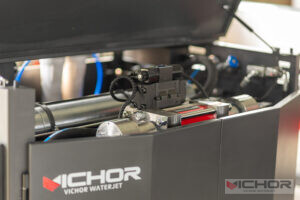
How a Water Jet Drilling Machine Works: Principles, Applications, and Solutions
In the world of precision cutting and drilling, few technologies offer the versatility and power of a water jet drilling machine. This innovative tool harnesses the simple force of water, and often abrasive materials, to slice through and penetrate some of the toughest materials on earth with astonishing accuracy. Unlike traditional methods that rely on heat or physical force, waterjet technology provides a cool, clean, and incredibly precise alternative. Whether you’re in aerospace, mining, or art fabrication, understanding the capabilities and nuances of this technology is crucial. This article delves deep into the inner workings, benefits, and common challenges of using a water jet drilling machine.
What is a Water Jet Drilling Machine and Its Core Principle?
At its most fundamental level, a water jet drilling machine is a tool that uses a very high-pressure stream of water to cut or drill into material. The core principle is based on transferring immense pressure, created by a powerful pump, into kinetic energy as the water is forced through a small orifice, called a jewel nozzle.
This process typically involves two stages:
Pressurization: An intensifier pump or a direct drive pump takes in normal municipal water and pressurizes it to extreme levels, often between 60,000 and 90,000 PSI (4,000 to 6,200 bar).
Focusing and Erosion: This ultra-high-pressure water is then focused through a tiny hole in the jewel nozzle (usually made of diamond or sapphire), creating a supersonic stream moving at speeds over Mach 3. For drilling or cutting harder materials like metals, stone, or ceramics, a granular abrasive (like garnet) is sucked into the stream via a venturi effect in the mixing chamber. This abrasive-waterjet mixture does the actual cutting through mechanical erosion, not heat.
The result is a clean, precise, and heat-affected zone (HAZ)-free cut or hole.
The Unmatched Advantages of Using a Water Jet System
The growing popularity of the water jet drilling machine is no accident. It offers a unique set of advantages that other technologies struggle to match.
No Heat-Affected Zone (HAZ): This is arguably its greatest benefit. Since the process uses cold-cutting, it does not alter the molecular structure of the material. There is no hardening, warping, or residual stress, which is critical for materials like tool steel, titanium, and tempered glass.
Material Versatility: A single water jet drilling machine can process a breathtaking range of materials. One minute it can be cutting through soft rubber, foam, or food products with a pure waterjet, and the next it can be drilling holes in 8-inch-thick titanium, granite, or bulletproof glass with an abrasive jet.
High Precision and Flexibility: CNC-controlled systems offer exceptional accuracy, allowing for complex shapes, sharp corners, and intricate details that would be difficult or impossible with lasers or plasma cutters. The kerf (width of the cut) is very small, minimizing material waste.
Environmentally Friendly: The process produces no hazardous fumes or vapors. The primary waste is wet abrasive and small material particles, which are generally non-toxic and easier to dispose of compared to the fumes from thermal cutting.
Key Industries and Applications for Water Jet Drilling
The unique capabilities of the water jet drilling machine make it indispensable across a wide spectrum of industries.
Aerospace and Aviation: Used for cutting and drilling heat-sensitive composites like carbon fiber, titanium alloys, and aluminum without compromising their structural integrity.
Architecture and Art: Perfect for creating intricate designs in marble, granite, glass, and metal for countertops, sculptures, and decorative panels.
Mining and Construction: Employed for precise cutting in tunnel boring, concrete demolition, and cutting rebar. Abrasive water jets are incredibly effective on reinforced concrete.
Automotive: Used for cutting interior components like gaskets, carpets, and insulation (pure waterjet) as well as exterior parts like body panels and trim (abrasive jet).
Manufacturing: A go-to solution for prototyping, tool and die making, and cutting parts from materials that are difficult to process with other methods.
Comparing Water Jet Drilling to Traditional Methods
How does a water jet drilling machine stack up against lasers, plasma, and mechanical milling?
vs. Laser Cutting: Lasers are fast and precise but generate extreme heat, creating a HAZ. They are also limited in material thickness and cannot effectively cut reflective materials like copper or brass. Waterjets have no such limitations.
vs. Plasma Cutting: Plasma is excellent for quickly cutting thick conductive metals but is messy, produces a large HAZ, and is generally less precise. It is also limited to electrically conductive materials.
vs. EDM (Electrical Discharge Machining): EDM is highly precise but very slow and can only cut conductive materials. Waterjet is significantly faster for most applications.
vs. Mechanical Drilling: Drill bits wear out, require constant cooling, and can cause work-hardening or cracking in brittle materials. A water jet is a tool-less process, meaning no bits to break or replace, only the nozzle and abrasive.
Common Challenges and Problems with Water Jet Drilling Machines
While powerful, operating a water jet drilling machine is not without its challenges. Understanding these common issues is key to effective operation and maintenance.
1. Nozzle and Component Wear
The abrasive slurry is extremely erosive, and while it’s meant to cut the material, it also slowly wears down the machine’s components. The jewel orifice (usually sapphire or diamond), the abrasive mixing tube (made of tungsten carbide or ceramic), and the seals are all consumable parts. They require regular inspection and replacement to maintain cut quality and accuracy. A worn nozzle will produce a wider, less focused stream, leading to tapered cuts and poor edge quality.
2. Taper and Accuracy at High Speeds
A inherent characteristic of the abrasive waterjet stream is that it widens slightly as it travels. This can create a minor taper on the cut edge, meaning the top of the cut is slightly wider than the bottom. For most applications, this is negligible, but for high-precision parts, it requires compensation strategies like dynamic head tilting or slower cutting speeds.
3. Managing Abrasive and Water Usage
An abrasive water jet drilling machine consumes a significant amount of garnet abrasive and water. While water is often recycled in closed-loop systems, the abrasive is a single-use consumable. This creates ongoing material costs and a waste stream of spent abrasive and water slurry that must be filtered and disposed of properly.
4. Slow Cutting Speed on Thick, Hard Materials
While a waterjet can cut through incredibly thick materials, the process is not always the fastest. For instance, cutting through 6 inches of hardened steel will be much slower than a plasma cutter on the same thickness. The trade-off is precision and lack of HAZ. Operators must find the right balance between speed, quality, and cost for each job.
5. Delamination and Water Intrusion on Laminates
When drilling or cutting laminated materials like certain composites or layered metals, high-pressure water can seep between the layers, causing delamination or swelling. This requires careful programming of the pierce points and potentially the use of a “dry” piercing method or a starter hole to prevent damage.
Selecting a system depends heavily on your primary applications. Key considerations include:
Pump Pressure: Higher pressure (90,000+ PSI) allows for faster cutting speeds and better efficiency on hard materials.
Table Size and Configuration: Ensure the machine’s bed is large enough for your typical workpieces.
Abrasive vs. Pure Water: Do you need to cut both soft materials (requiring a pure waterjet head) and hard materials (requiring an abrasive head)? Many systems offer a quick-change option.
CNC Controller: The software and controller are the brains of the operation. Look for user-friendly software that supports the file types and cutting complexities you require.
In conclusion, the water jet drilling machine is a remarkably flexible and powerful piece of industrial technology. Its ability to cold-cut virtually any material without altering its intrinsic properties makes it an invaluable asset in modern manufacturing and fabrication. By understanding its principles, advantages, and potential pitfalls, businesses can leverage this technology to unlock new levels of creativity and efficiency in their production processes.
continue reading
Related Posts
- 1371 words6.9 min read
- 1449 words7.3 min read


